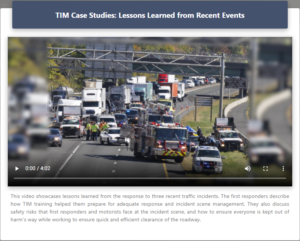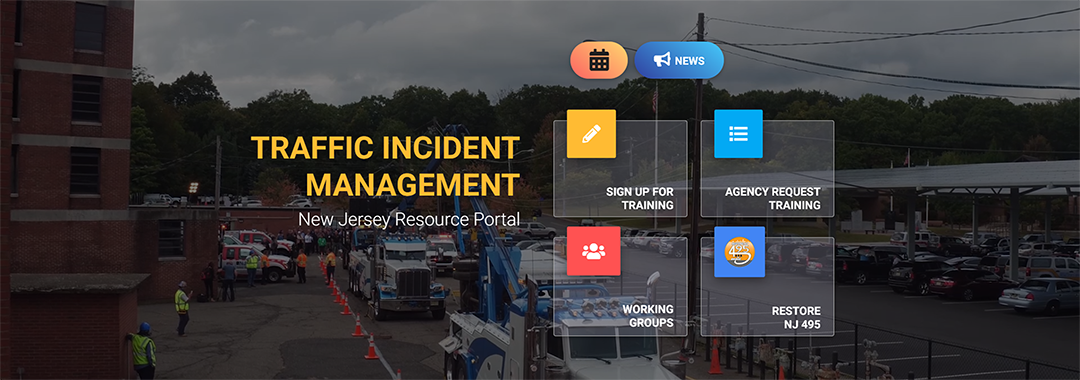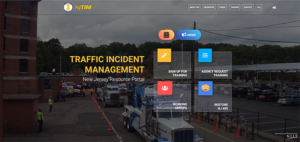
NJDOT’s Traffic Incident Management Program offers training and resources to improve the coordinated response to traffic incidents. Source: NJTIM website
NJDOT’s New Jersey’s Traffic Incident Management (TIM) program consists of a planned and coordinated multi-disciplinary process to detect, respond to, and clear traffic incidents so that traffic flow may be restored as safely and quickly as possible after an incident. According to the 2015 State of New Jersey Traffic Incident Management Strategic Plan, about half of all traffic congestion is caused by temporary, one-time occurrences, such as crashes, disabled vehicles, spilled cargo, highway maintenance and reconstruction, adverse weather, and planned special events. These occurrences reduce roadway capacity, disrupt the normal operation of the transportation system, increase the risk of secondary crashes, and result in lost time and productivity, increased cost of goods and services, negative impacts on air quality and the environment, and reduced quality of life and motorist satisfaction.
By reducing the duration and impact of traffic incidents, effective traffic incident management practices improve the safety of crash victims, other motorists, and emergency responders. TIM practices are designed to reduce the time to detect, respond to, investigate, and safely clear the incident, to safely manage personnel and equipment at the site, provide timely and accurate information to the public, and to manage affected traffic until normal conditions are restored. Stakeholders in the Traffic Incident Management program include federal, state, and local agencies and private sector partners including emergency medical services (EMS), fire and rescue, law enforcement, transportation agencies, medical examiners and coroners, hazardous materials contractors, towing and recovery, emergency management, public safety communications, and traffic information media.
The FHWA’s Every Day Counts (EDC) program, in cooperation with the second Strategic Highway Research Program (SHRP2), offered the first national traffic incident management process and training program as an innovation under EDC-2 in 2013-2014. First offered in 2010, NJDOT’s classes in TIM predated the FHWA EDC initiative. The NJ TIM Responder Training provides interactive, hands-on incident resolution exercises to help participants learn to coordinate incident response activities and optimize operations in the field. The training supports development of a unified practice among all stakeholders. NJDOT has continued to train in TIM during the pandemic and, as of September 1, 2020, the program has trained 29,798 incident responders.
In alignment with the 2015 Strategic Plan, NJDOT and the ITS Resource Center at the New Jersey Institute of Technology, developed the NJ TIM website in 2016 to provide support to the TIM program. Recently, they have modernized the website through the addition of new content, including videos and other resources such as case studies and training recaps. A schedule of virtual trainings, and registration for individual and group training, are available. The website provides links to the Strategic Plan and Safety Guidelines for Emergency Responders, as well as contact information for all federal, state, county, and local law enforcement agencies operating in the state.
Through EDC-4, FHWA promoted the use of data to improve traffic incident management. NJDOT is increasingly looking to technology to improve safety at incident sites. A pilot study looked at the effectiveness of using connected vehicle technology on 32 safety service vehicles to alert drivers to the presence of safety service patrol (SSP) workers via the mobile navigation app Waze. NJDOT established a Computer-Aided Dispatch (CAD) Integration Working Group to develop a plan for CAD integration among New Jersey agencies and other organizations. Using the OpenReach system, NJDOT has implemented the FHWA key performance measures: roadway clearance time; incident clearance time; and number of secondary crashes. Traffic incident management data sharing between the NJDOT and law enforcement systems is expected to decrease incident response times, properly capture the incident timeline, and improve the traffic incident management process. More information on these efforts can be found at the NJDOT Technology Transfer website.




